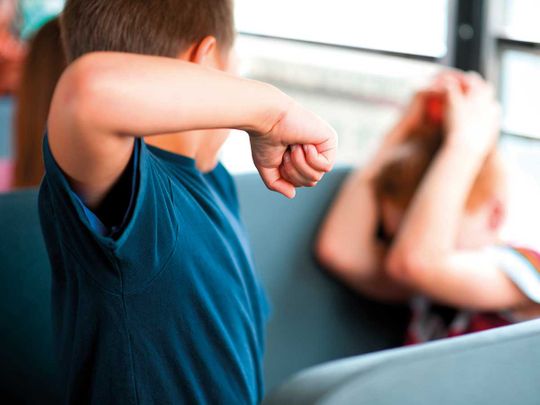
Dubai Health Authority on Monday turned the spotlight on verbal bullying. It explained in a tweet, “Verbal bullying is when a person uses certain works or comments in order to insult or underestimate the victim. Bullies create an image of a strong and controlling person. Verbal bullying can happen face-to-face or online.”
Of course there’s more than one sort of bullying - they can actually be classified into:
- Physical,
- Verbal or emotional,
- Cyber, and
- Social.
While the pandemic has seen an uptick in all bullying, a 2021 survey by Cartoon network and YouGov, conducted in February that saw 2,015 parents across the UAE and Saudi Arabia weigh in, found that two out of five parents has seen an increase in cyber bullying during the pandemic. Other findings of the study: 35 per cent think that verbal bullying is the most common form of bullying that’s happening.
Verbal bullying may just have the most detrimental impact on the psyches on young people. Mandeep Jassal, Behaviour Analyst, Priory Wellbeing Centre, Dubai, explains: “Verbal bullying is a form of emotional abuse which is equally if not more damaging than physical bullying and abuse.”
Some kids are more prone to bullying. These include, explained Clinical Psychologist Dr Haneen Jarrar to Gulf News:
- kids who are more likely to be aggressive,
- kids who are more likely to be impulsive,
- those who see aggression as normal or not something to worry about,
- those who blame others for their own mistakes or tend to be too hyper active.
But while one of the most difficult things to accept is that your own child might be a perpetrator, there are some red flags all parents should be aware of. The signs of a bully, as per the DHA tweet are:
- Mocking and making fun of others
- Calling others names that they don’t like
- Spreading rumours about others
Are these behaviours sounding familiar? Don’t worry, it’s not irreparable.
Wondering how one can change? Talk to them about:
- Stopping being around other bullies – group mentality may do more harm than good.
- Help them get in touch with someone they trust – even if it isn’t you – to analyse their feelings.
- Ask them to apologise to the person they have bullied.
- Help them find some positive ways to deal with their feelings and emotions.
- Help them make new friends and form positive relationships with people.
“The next step was incredibly powerful. The boy who was suffering the bullying was asked to participate in an activity. He agreed and that empowered him a lot. We had both boys sit facing each other. The boy who was being bullied was asked to explain how the bullying made him feel. The bully had to respond with ‘What I hear you saying is...’ and then repeat what he had been told. This effect was almost immediate. You could see the penny drop as he began to understand the consequences of his actions. Behaviour modification is so much more powerful than punishment or the threat of punishment. It is not only the victim who needs help, but the bully as well,” Kilian explained.
Bullies can also be helped by a counsellor by undergoing cognitive and behavioural therapy. Jassal explains: “An individual often learns thoughts and beliefs about themselves, others and the world around them during childhood. These thoughts and beliefs can be dysfunctional and unhelpful if the individual has been told they are not good enough or if their feelings were not validated at a young age. These thoughts, for example, can be about the ‘self’, such as ‘I am not good enough’, about others, such as ‘people cannot be trusted’ and beliefs about the ‘world’, such as ‘the world is an unsafe place to be in’.
“Changing these patterns of thoughts and feelings is possible through talking therapy along with changing behaviours to more functional ones.”
The lesson here: bullies are not born but made – and they can be unmade as well.








